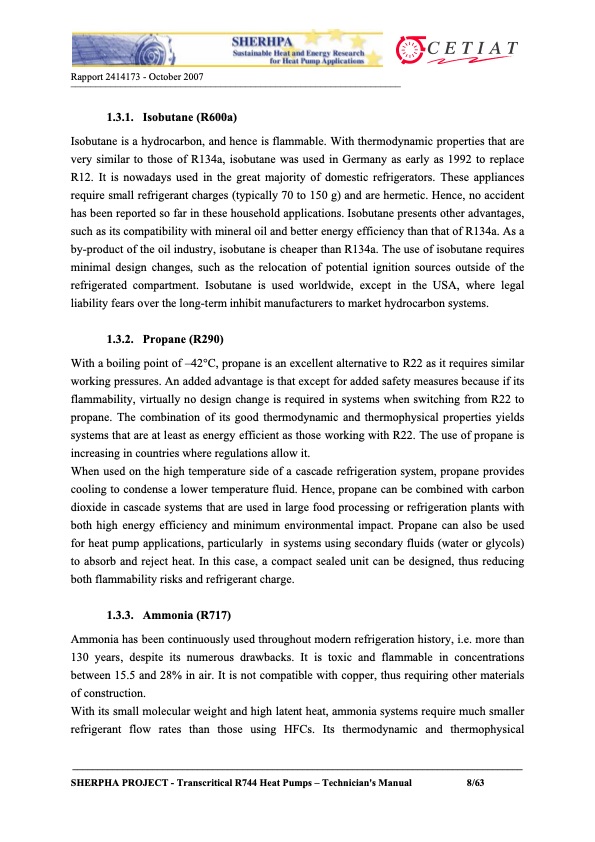
PDF Publication Title:
Text from PDF Page: 009
Rapport 2414173 - October 2007 __________________________________________________________________ 1.3.1. Isobutane (R600a) Isobutane is a hydrocarbon, and hence is flammable. With thermodynamic properties that are very similar to those of R134a, isobutane was used in Germany as early as 1992 to replace R12. It is nowadays used in the great majority of domestic refrigerators. These appliances require small refrigerant charges (typically 70 to 150 g) and are hermetic. Hence, no accident has been reported so far in these household applications. Isobutane presents other advantages, such as its compatibility with mineral oil and better energy efficiency than that of R134a. As a by-product of the oil industry, isobutane is cheaper than R134a. The use of isobutane requires minimal design changes, such as the relocation of potential ignition sources outside of the refrigerated compartment. Isobutane is used worldwide, except in the USA, where legal liability fears over the long-term inhibit manufacturers to market hydrocarbon systems. 1.3.2. Propane (R290) With a boiling point of –42°C, propane is an excellent alternative to R22 as it requires similar working pressures. An added advantage is that except for added safety measures because if its flammability, virtually no design change is required in systems when switching from R22 to propane. The combination of its good thermodynamic and thermophysical properties yields systems that are at least as energy efficient as those working with R22. The use of propane is increasing in countries where regulations allow it. When used on the high temperature side of a cascade refrigeration system, propane provides cooling to condense a lower temperature fluid. Hence, propane can be combined with carbon dioxide in cascade systems that are used in large food processing or refrigeration plants with both high energy efficiency and minimum environmental impact. Propane can also be used for heat pump applications, particularly in systems using secondary fluids (water or glycols) to absorb and reject heat. In this case, a compact sealed unit can be designed, thus reducing both flammability risks and refrigerant charge. 1.3.3. Ammonia (R717) Ammonia has been continuously used throughout modern refrigeration history, i.e. more than 130 years, despite its numerous drawbacks. It is toxic and flammable in concentrations between 15.5 and 28% in air. It is not compatible with copper, thus requiring other materials of construction. With its small molecular weight and high latent heat, ammonia systems require much smaller refrigerant flow rates than those using HFCs. Its thermodynamic and thermophysical __________________________________________________________________________________________ SHERPHA PROJECT - Transcritical R744 Heat Pumps – Technician's Manual 8/63PDF Image | Transcritical R744 (CO2) Heat Pumps 2017

PDF Search Title:
Transcritical R744 (CO2) Heat Pumps 2017Original File Name Searched:
Manuel-CO2.pdfDIY PDF Search: Google It | Yahoo | Bing
CO2 Organic Rankine Cycle Experimenter Platform The supercritical CO2 phase change system is both a heat pump and organic rankine cycle which can be used for those purposes and as a supercritical extractor for advanced subcritical and supercritical extraction technology. Uses include producing nanoparticles, precious metal CO2 extraction, lithium battery recycling, and other applications... More Info
Heat Pumps CO2 ORC Heat Pump System Platform More Info
| CONTACT TEL: 608-238-6001 Email: greg@infinityturbine.com | RSS | AMP |